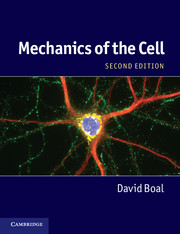Book contents
- Frontmatter
- Contents
- Preface
- List of symbols
- 1 Introduction to the cell
- 2 Soft materials and fluids
- Part I Rods and ropes
- Part II Membranes
- Part III The whole cell
- 10 The simplest cells
- 11 Dynamic filaments
- 12 Growth and division
- 13 Signals and switches
- Appendix A Animal cells and tissues
- Appendix B The cell’s molecular building blocks
- Appendix C Elementary statistical mechanics
- Appendix D Elasticity
- Glossary
- References
- Index
13 - Signals and switches
Published online by Cambridge University Press: 05 June 2012
- Frontmatter
- Contents
- Preface
- List of symbols
- 1 Introduction to the cell
- 2 Soft materials and fluids
- Part I Rods and ropes
- Part II Membranes
- Part III The whole cell
- 10 The simplest cells
- 11 Dynamic filaments
- 12 Growth and division
- 13 Signals and switches
- Appendix A Animal cells and tissues
- Appendix B The cell’s molecular building blocks
- Appendix C Elementary statistical mechanics
- Appendix D Elasticity
- Glossary
- References
- Index
Summary
The cell is a dynamic object that grows, divides and, in some cases, locomotes. Even if its growth is the simple exponential volume increase observed for some genera in Chapter 12, various biochemical pathways continually open and close as required during the division cycle. Further, multicellular organisms as a whole display cell differentiation and cooperative behavior that occur on macroscopic time scales; an example of the latter might be the response of a muscle to the receipt of sensory input. These types of processes imply the transmission of information over a variety of length scales, and the existence of switches that can activate or deactivate processes within cells.
In this chapter, we illustrate some of the mechanisms that underlie switching and signal transmission. The classic example is signal transmission along the axon of a nerve: here, we describe the behavior and physical basis of the axon’s action potential in Section 13.1 and then establish a theoretical framework for its analysis in Section 13.2. The framework was developed by Hodgkin and Huxley (1952) based on their own experimental findings, which were obtained in part with B. Katz. Following this, Section 13.3 takes a mathematical look at the structure of equations that possess switch-like features. There are many examples of switches in both the genetic and the mechanical functioning of the cell, and two of these are treated in Section 13.4.
- Type
- Chapter
- Information
- Mechanics of the Cell , pp. 496 - 524Publisher: Cambridge University PressPrint publication year: 2012



